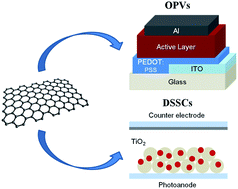Graphene in photovoltaic applications: organic photovoltaic cells (OPVs) and dye-sensitized solar cells (DSSCs)
Abstract
Graphene, a one-atom thick layer of graphite with a two-dimensional sp2-hybridized carbon network, has recently attracted tremendous research interest due to its peculiar properties such as good mechanical strength, high thermal conductivity, superior transparency, large specific surface area and exceptional charge transport properties. To take advantage of its unusual properties, graphene has been widely studied in various energy conversion and storage applications such as supercapacitors, fuel cells, batteries and solar cells. Amongst these applications, the development of efficient solar cells, which can convert sunlight into electricity is in high demand in order to solve up-coming energy-related and global warming issues. So far, significant effort has been devoted to using graphene for improving the overall performance of photovoltaic devices such as organic photovoltaic cells (OPVs) and dye sensitized solar cells (DSSCs). It has been reported that graphene can play diverse, but positive roles such as an electrode, an active layer, an interfacial layer and an electron acceptor in photovoltaic cells. Herein, we summarize the recent progress and general aspects of graphene in various photovoltaic cells including the synthesis, structure, properties and performance. In addition, challenges and future perspectives in this field are also discussed.


 Please wait while we load your content...
Please wait while we load your content...